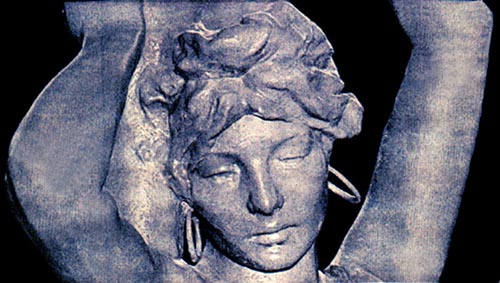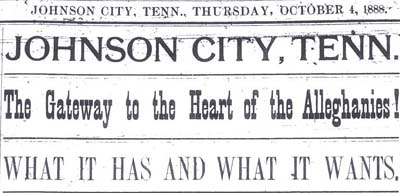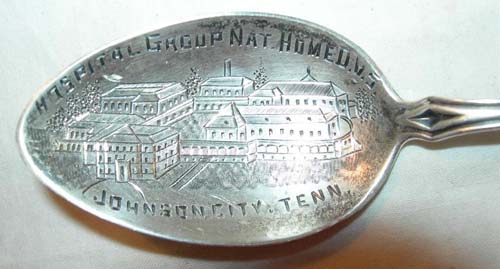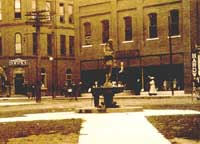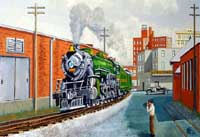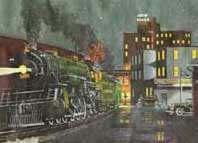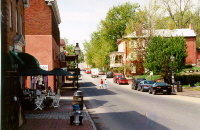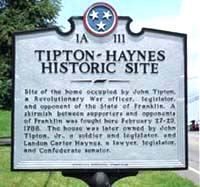Johnson City, Tennessee without question was
historically (and still is) a railroad town. Three railroads
crossing in the middle of the downtown area propelled Johnson City from
a village of 600 people in 1880 to the fifth largest city in Tennessee
with a population of over 25,000 in 1930. A sort of "lab
mouse" for the nineteenth century railroad builders, Johnson
City's physical layout is completely unique from almost any city anywhere.
Johnson City’s history has been somewhat overshadowed in
comparison to neighboring frontier towns of Jonesborough, Greeneville,
and Elizabethton, earlier settlements with very impressive historical
lineages. Two U.S. Presidents, Andrew Jackson and Andrew Johnson lived
in Jonesborough and Greeneville respectively. Elizabethton was a key staging
area for the Battle of King’s Mountain in the Revolutionary War
as well as home to legendary tribal settlements of the Cherokee Indians
along the Watauga River. These towns were all thriving villages decades
before Johnson City "Founding Father" Henry Johnson's birth
in 1809 and were mature cities prior to the Civil War.
In Tennessee, the four largest cities, Memphis, Nashville, Knoxville, and Chattanooga all formed at strategic river locations since river transport was the primary means to move goods inland in the early 19th Century. Jonesborough, Greeneville and other Northeast Tennessee towns lacked the river ports for major growth and basically served as staging areas for westward migration. The State of Tennessee grew in population from around 35,000 to over one million from 1790 until 1850 (an astounding increase) and Tennessee was one of the most prominent states in the Union prior to the Civil War.
Then came the railroads….. Johnson City was essentially born in the last quarter of the nineteenth century when there were dreams of a “New South” in which the former “disloyal” southern states became part of the industrial revolution and built economic strength no longer based on agriculture. Johnson City was one of the early experiments in rapid industrialization and the full throttle development of railroad related industries and trade area expansion. Development of the railroad system was the missing element in tapping the natural resources (primarily timber and minerals) of the Appalachian region. Lacking the advantages of rivers for transport Washington County, Jonesborough, and Johnson City aggressively supported railroad expansion as a way to “level the playing field” and take full advantage of the new “iron horse” that was changing America.
Ironically a Union Civil War General, John T. Wilder, was a leader in the industrial development of the State of Tennessee, with heavy involvement in Chattanooga and Johnson City. Wilder was famous as commander of an Indiana Regiment, known as the Lightning Brigade during the war, and he realized the potential of Tennessee and its mountain regions for raw materials while serving in multiple Civil War campaigns and viewing the state’s abundant natural resources.
Johnson City was seen as a potential “Pittsburgh of the South.” Wilder and other northern capitalists sought mineral rights, railway rights-of-ways, and bought thousands of acres during the 1880s to develop raw materials and start new industrial towns with Johnson City, Tennessee being one of the focal points. Johnson City and its booming industrial suburb called Carnegie, grew at a phenomenal rate between 1882 and 1892. However, an unforeseen world-wide depression, the Financial Panic of 1893 forced many major railroads and related industries into bankruptcy and the grandiose dreams of Wilder and his investors ended abruptly. John Wilder lost a personal fortune and Johnson City went from “boom town” momentum to a land of broken dreams and misfortune in quick fashion.
Walter P. Brownlow, Congressman for the First Congressional District, had another vision for Johnson City. In 1901 Brownlow sought a “branch” of the National Home for Disabled Volunteer Soldiers for his District, a proposal not in keeping with the policies of Congress who had previously decided there would be no more “National Soldiers Homes” built. Brownlow argued his case before Congress, asked for five minutes to speak and only took three. He argued that one of the Soldiers Home branches should be located in the southern states; that possibly the North would have lost the Civil War without the loyalty of Brownlow’s 1st Congressional District who although in a seceding state (Tennessee) remained loyal to the United States government and aided the federal occupation of Tennessee and the state’s return to the Union in 1863; and that the waiting list for veterans to get into a Soldiers Home was far too long and more capacity was needed quickly. Brownlow, at the time arguably the most powerful member of Congress in the South, succeeded in getting unanimous votes in the House of Representatives and the U.S. Senate for his proposal. The Mountain Branch of the Soldiers Home opened for business in October 1903. Brownlow’s magnificent Soldiers Home campus now houses the fourth largest VA Medical Center in the nation as well as the Quillen College of Medicine.
In 1906, George L. Carter moved to Johnson City to undertake another ambitious project – the completion of the Carolina, Clinchfield and Ohio Railway. Picking up the remnants of several previous efforts to build a new railway across the Blue Ridge Mountains, Carter and his associates built a railroad to standards unheard of for their time. The $30 million dollar railroad was only the means of transport for Carter’s regional empire which included coal mining interests in Virginia, the founding of a model industrial town called Kingsport, and development of an entire section of Johnson City with a new state university, magnificent residential areas (Tree Streets), the Model Mill (later General Mills) and several other major industries.
It is impossible today in the 21st Century to realize the impact the railroads had in the nineteenth and early 20th Centuries. At a banquet in honor of the extension of the ET&WNC Railway into Boone, North Carolina in 1919, a gentleman of that area was asked to speak. He said “I remember when the only way a person could get to Boone was to be born there.” This was an accurate statement of the virtual isolation of many mountainous areas prior to railroad accessibility.
These are but a few of the stories retold here
at “Johnson’s Depot” and Henry’s Associates
are picking up new volunteers continually who are willing to research
leads and clues to the past and share items related to local history.
Sometimes a few folks ask……
Is Johnson City really all that historic anyway and is Johnson’s Depot worth commemorating as a historic district or site?
In a recent article for Preservation magazine Dwight
Young makes the following observations:
“ Even though they don't merit long and dramatic entries in
the history books, the places where most of us live are hugely important
and eminently worth saving. They say a lot about who we are and how we
got here. Each is a kind of monument. Maybe no great battles were fought
there—except for the ceaseless struggle to make a living out of
dirt or rock or water. Maybe no deathless oratory was uttered—just
the everyday jokes and curses and threats and endearments spoken by people
building lives for themselves. Maybe no great empires were won or lost—apart
from the putting down of roots, the pushing back of the frontier, the
flexing of industrial muscle that heralded a nation's coming of age. Monuments
come in many forms, not all of them involving heroes on horseback. Once
you realize that, "monument" doesn't seem too far-fetched a
label for an ordinary town.”
While not having a long notation in many history books,
Johnson City, Tennessee is hard to label as an ordinary town.
It could be that it’s story has just not been fully told.
Come along with us for a cruise through history and decide
for yourself what you can make of it all……. Beware it is a
wild and wooly ride. It's all here at Johnson's Depot
including the town's tendency toward Prohibition-era neglect of federal
law earning the city the nickname of "Little
Chicago."
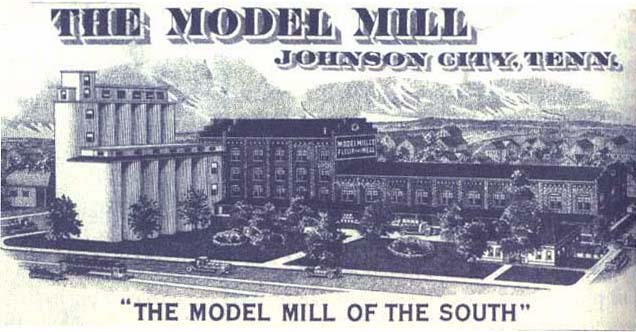 |
|
|
|
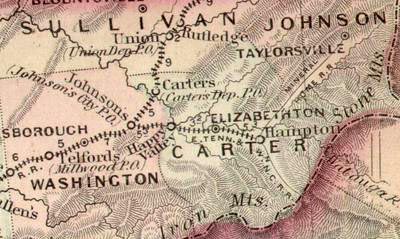 |
|
|
|||||||||||||||||||||||||||||
|
|||||||||||||||||||||||||||||
|
